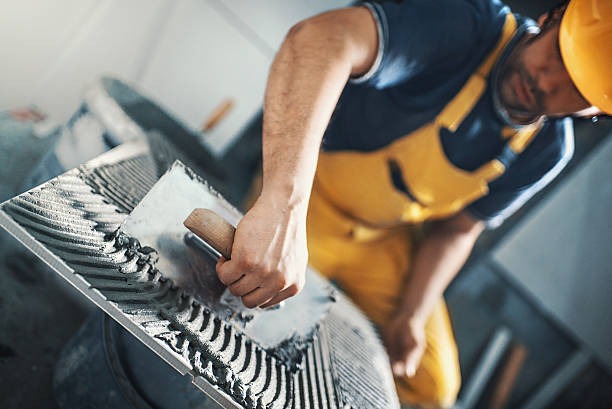
Large-format and slab tiles are increasing in popularity with contractors because of their ability to create an aesthetically pleasing appearance. These tiles are unique and pose their own challenges during installation.
Properly drying these large tiles prior to fixing down will allow you to determine the layout that best suits your project. It is important to do this before installing floor tiles which are planks of length and mimic wood linen.
Installation
The time spent preparing a wall or floor for tile installation is critical to ensure a smooth, beautiful look. This is crucial when dealing with large-format or slab tiles that can be very heavy. Every step from mixing the mortar to that final wiggle of the tile counts!
The large tiles add the appearance of luxury and continuity to any space. They also require fewer pieces for installation that means that they are more streamlined and efficient process.
For a proper installation of large-format tiles it is important to apply a substantiallayer adhesive to the substrate. The best adhesive to use is one that has high-performance properties and is resistant to sliding and also helps to reduce lippage. This kind of mortar mix is readily available from your local supply store.
Once the floor is ready for tile installation, it’s time to think about your layout. Here, a careful application can transform a large tile stack into a seamless floor or wall. The most effective way to start is to draw a layout line. This can be accomplished by using the level laser to create vertical and horizontal lines starting from the center. Prior to setting the tiles it is a good idea to “back butter” the tiles.
Cutting
They provide a seamless and visually appealing surface. This reduces the need for renovations and helps to promote a sustainable lifestyle. They also permit the use of less grout lines, creating an amazing focal point, and elegant design that is in line with the style of your home.
A well-prepared substrate will stop or limit cracks and lippage. Therefore, it’sa good idea to grind areas that are high and patch lower ones prior to installation. Also, you should conduct a dry-layin order to make sure your layout is accurate.
Once your surface is solid and flat, you are able to begin cutting. It’s crucial to follow the manufacturer’s directions with care when using a tile cutting machine. Plan your cuts and lay the tiles before you begin, particularly in the case of slabs of tiles that are difficult to remove once laid. One small error could have a major impact on the overall appearance of your work. It will also decrease the amount of trash, and you’ll be able to save money for materials and work.
Layout Plan
If you’re looking for a tilethat’s not only tough but also fashionable, then a porcelain slabs are the best ideal choice. These large tiles offer an array of textures and patterns, from classic to contemporary, that can be used in all kinds of designs. Their larger sizes also mean that they have less grout lines, making them easier to clean.
Layout planning is the process of arranging production equipment and materials in accordance with the requirements of the customer and local restrictions. This involves determining the area required for storage of materials making sure that all locations (e.g. the motorcycle barbershop or service station) have sufficient capacity and that the movement of materials and products is unhindered.
Three workers are required to move a slab that measures one millimeter by one millimeter. Two workers are required gach gia co to manage the slab while a third person acts as the spotter to ensure that the slab doesn’t fall over itself. In this video, MAPEI’s Chad Loveless acts as the spotter, while tile setters prepare the slab to be cut.
Lippage Control
A beautiful tile work is built upon two unassailable elements: a perfectly flat substrate and a smart, strategic layout. Get these right, and your installation will go smoothly. If you don’t, you’ll be fighting a losing battle with cracked tiles and an unattractive overall look.
Installers must adhere to manufacturer’s specifications and ANSI guidelines on flatness of the substrate in order to reduce the possibility of the problem of lippage. Installers should also make use of mortars that are specifically designed for large and heavy floor tiles to ensure adequate adhesiveness and support. Making the wrong choice of mortar may compromise the structural integrity of the flooring and hinder its ability to cure properly and cause shrinkage and lippage.
Another critical procedure is to install joint spacers between each slab to ensure a constant 3 mm space. This will allow the installer to easily locate and fix any shifts that may occur in the course ofinstallation, and ensures an even surface throughout the entire installation.
Handling
It is crucial to begin mixing the thin-set long before you mix the first bag. It all begins with meticulous preparation, including a perfectly flat floor and a clever, strategic layout. If you can get these elements right then your floor will become the monolithic and spacious one of your dreams. Get them wrong and you’ll be fighting lippage, broken tiles, or even just a mess.
The surface preparation is vital to any tile project. This is especially true for large slabs. The rigidity of these tiles magnifies any minor imperfections in the substrate, which can lead to uneven surfaces (known as “lippage”) and stress cracks after installation. To achieve a level, smooth surface requires meticulous cleaning, repairs to the substrate and leveling.
The most difficult aspect of working with large-format slabs is cutting clean and precise cuts. A standard score-and-snap cutter just won’t cut it, so you’ll need a high-quality wet saw capable of handling the huge material without causing damage to it. By ensuring that the cuts you make are always accurate, you can save time, money, and frustration.






